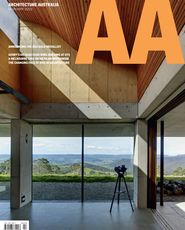Risk has had a bad rap. The typically negative connotations of risk assume it is something to be identified, assessed and managed out. In the construction industry, the management of risk accounts for a substantial portion of the building delivery process, bringing with it a raft of project and professional insurances. Meanwhile, within architectural practice, the management of risk drives a very large part of the mechanics of our business as we project an image of stability and certainty to prospective clients.
Yet this characterization puts our profession at risk as the business environment increasingly learns to embrace innovation as the necessary partner of success. Innovation here is code for risk. The new ventures, technologies and products that drive tomorrow’s innovations are predicated as a balance between risk and potential rewards. The banking, medical and finance sectors have accepted this and are swiftly adapting their business methods to meet new opportunities. These industries understand that risk associated with innovation is not a negative but rather a constituent part of creating new tools, methods and products that expand business and drive our economies forward. So while the driving force of the global economic environment has placed innovation at the core of the future economic agenda, how is architecture responding?
The short answer is, not well. One of the key reasons here is one of scale. Of the 14,006 registered practices in Australia only 2 percent employ more than twenty people. The profession is heavily biased towards Small and Medium Enterprises, which typically find it difficult to fund innovation. 1 If this structural challenge was not enough, there is also a culture of compliancy at work.
We think of architecture as a creative profession that innovates all the time. Every click or sketch is aimed at creating something new. However, not all design is innovative. This is the central misunderstanding of innovation in architecture, which continues to limit the profession’s understanding of risk as it misses business opportunities within the innovation economy. The result is that at the scale of macro-economics, design is recognized as playing a very minor part in the value supply chain and innovation networks. This at a time when innovation networks have become vitally important.
Networks
The Australian Innovation System (AIS) Report 2013 shows that businesses that commit to innovation are 78 percent more likely to report an increase in productivity from the preceding year. Additionally, those that collaborate outside their own domain are 242 percent more likely to report an increase in productivity. 2 So while architects continue to focus on evolving designs, the design and development of the businesses of architecture – the area with the greatest potential to reframe our discipline – is rarely discussed.
In fact, the dominant business model of today’s architect expressly avoids a list of elements that are trademarks of innovation. 3 This includes the sharing of intellectual property, broad collaboration, the allocation of a portion of business commitments to new and risky ventures, embracing outsourcing, developing metrics for capturing and assessing data, and developing niche services.
Take, for example, the trend towards niche business services springing up to take advantage of the repetitive tasks within workflows. Within architecture this has seen a shift from drafter to data-entry worker. With it documentation is slowly moving offshore. This represents a significant challenge, as the drafting room could be considered the engine of those businesses, and a culturally significant part of professional identity. They are a reservoir of disciplinary knowledge and training and, if nothing else, a significant stage in the billing cycle.
Yet the industry seems unwilling to acknowledge the crisis, even as predator businesses colonize niche architectural activities. For instance, digitization has transformed much of what is done within a practice, yet the development of new business opportunities that take advantage of this has not formed part of the disciplinary conversation. Digitization is typically seen as an efficiency system only, introducing incremental innovation at best.
Research
Why are we not more creative in how we adapt technology? What would it mean if architecture shifted from designing buildings to designing living infrastructures? This could capture new areas of work that rely on the native skill set of the architect, while framing the nature of that work differently. This, of course, would require research, a vital component in innovation. Yet the profession typically views research as a luxury or, at best, a project-based task. In other professional domains, however, research and development are central to the business model and a constituent part of the innovation cycle.
Research in this context principally takes on two forms. The first is research for “best practices,” which is applied to known projects and typically aimed at bettering systems, tools or products and which leads to incremental change. The second is the form of research aimed towards “new practices” looking for new opportunities for architecture to develop and leading to step change innovation.
This second form of research is more speculative and riskier as it occurs over longer time frames and has no direct target, but the pay-offs are much greater. The Google X projects are a good example of this type of research-led innovation: outcomes are fewer but their impact is game-changing or, to use current parlance, disruptive. It is this latter form of research that is largely absent from architectural practice as we know it today, but is also one of architecture’s biggest opportunities. If architecture as a practice takes the position that development of the practice (designing practice) is an essential part of success, then risk is an essential business proposition that it will have to get much more comfortable with.
Without attending to what should be the primary design project for architecture – the continual design and development of practice itself – architecture risks being an also-ran in the changing dynamics of our future economies, paradoxically at a moment at which our skills for spatial and synthetic problem-solving are most in demand.
Opportunities
Within this context there are immediate opportunities for architecture from the perspective of risk and new practice models. Arguably our most critical skills include the soft skills required for cultivating relations, advocating good design and negotiating the politics of procurement. Equally a new range of technological skills is required not only to navigate practice, but also to innovate within the potentials it offers. The mythical figure of the lone architect needs to be immediately replaced by that of the networked professional, drawing expertly on the skills of a team and a broader business environment. This change should be reflected in areas such as registration and universities.
Most importantly we must look outside of our industry. Innovation literature repeatedly highlights the need to be engaged in broad industry networks in order to develop. Not only does competition between practices as they currently exist diminish the chances of practice success, it inhibits the development of the profession more generally by limiting the capacity for knowledge transfer, stifling innovation and precluding architecture from conceptualizing its role within a larger value supply dynamic. But why is this the case? The traditional practice model isolates itself in order to protect its intellectual property (IP), yet that IP is traditionally limited to building design, and the broader areas of innovation are missed. In professional terms there are no good reasons to be isolationist and plenty of bad reasons.
As we see in today’s business world, risk is a necessary ingredient within any innovation, and innovation is necessary not only for success but also for survival. Architecture takes its greatest risk if it does not develop ways to innovate what it does and embrace the risk that comes with that.
1. Siemens, “Picture the Future: Australia 2030,” Productivity report, 2011, http://www.siemens.com.au/picturethefuture, 11 (accessed 2 February 2015).
2. “Australian Innovation System Report 2013,” Australian Government Department of Industry and Science website http://www.industry.gov.au/science/policy/AustralianInnovationSystemReport/AISR2013/wp-content/uploads/2013/11/AIS-Innovation-Systems-Report-2013-v3.pdf, 10 (accessed 2 February 2015).
3. This is supported by the Creative Industries Innovation Centre’s (CIIC) “Architecture Forensic Report” (June 2014) that lists business development as one of the key challenges for the sector.
Source

Discussion
Published online: 30 Apr 2015
Words:
Anthony Burke
Issue
Architecture Australia, March 2015
















